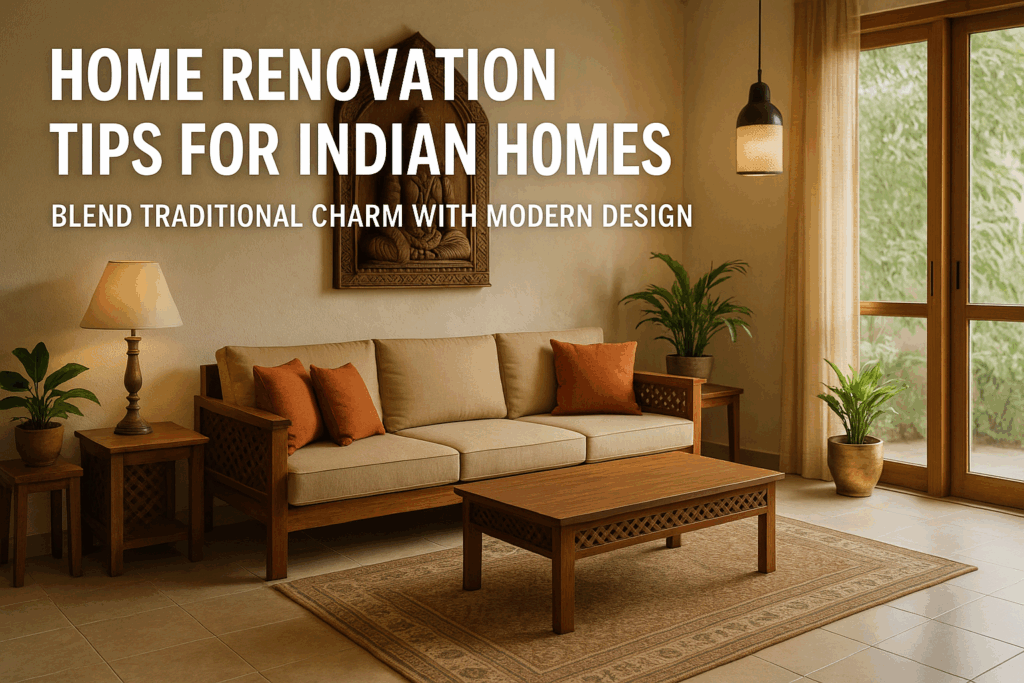Home Renovation Tips for Indian Homes That Blend Traditional Charm with Modern Design
The architectural legacy of Indian homes is unmatched. From ornate wooden columns to intricate jharokhas and airy courtyards, traditional Indian homes reflect a rich cultural heritage. However, as lifestyles evolve, so do design preferences. Many homeowners find themselves looking for residential interior renovation tips for old homes in India—where the goal is to retain the timeless charm while embracing contemporary comfort and functionality.
At Forklyft Design Studio, the belief is simple: old homes don’t need to be replaced—they need to be reimagined. In this comprehensive guide, discover practical and inspiring renovation strategies that honor the soul of your home while making space for modern living.
1. Start with a Structural Assessment
Before jumping into paint swatches and furniture catalogs, it’s crucial to understand the structural integrity of your home. Older homes, especially those built 30+ years ago, often require reinforcement or updates to foundation, beams, and electrical systems.
What Forklyft Design Studio Recommends:
- Hire a professional to assess walls, floors, roofing, and plumbing
- Check for signs of water damage, termites, or crumbling plaster
- Ensure the house can support new fittings like modular wardrobes or false ceilings
Budget Tip:
Focus your investment on essential repairs first. Cosmetic upgrades can follow once the home is structurally sound.
2. Retain and Restore Signature Elements
The charm of an old Indian home often lies in its handcrafted details—ornate doorways, mosaic floors, teak wood staircases, or lattice windows. Instead of replacing them, consider preserving and highlighting these features.
Ways Forklyft Design Studio Revives Traditional Elements:
- Sanding and polishing old woodwork to bring back luster
- Re-tiling damaged but iconic mosaic or Kota stone floors
- Framing antique window grilles as functional decor pieces
- Reusing old brass handles and locks for doors and cabinets
Pro Tip:
Contrast these vintage elements with minimalist modern finishes to create a balanced look.
3. Plan a Space-Efficient Layout
Old Indian homes were designed for a different era—where closed rooms, high ceilings, and separate kitchens made sense. Today’s needs are more open, flexible, and tech-enabled. Without erasing the layout completely, Forklyft Design Studio reimagines interiors with fluidity and purpose.
Popular Layout Tweaks:
- Knocking down partial walls to create open-plan kitchens or living areas
- Combining small storage rooms to build walk-in closets
- Converting one large room into a home office plus guest bedroom
Smart Move:
Forklyft Design Studio designs transitional layouts that allow homes to function as both multi-generational spaces and private retreats.
4. Blend Materials from the Past and Present
Blending the old with the new requires more than aesthetics—it needs harmony in materials. The goal is to create contrast without conflict.
Forklyft’s Design Studio Material Fusion Techniques:
| Traditional Element | Modern Pairing |
| Handcrafted wood | Matte laminates or acrylics |
| Red oxide floors | Textured tiles or polished concrete |
| Jaali partitions | Glass and wood panels |
| Lime plaster walls | Neutral paint shades |
By respecting the soul of the material, Forklyft Design Studio ensures your home feels rooted yet relevant.
5. Maximize Natural Light and Ventilation
Older homes were built to breathe. Thick walls and high ceilings kept interiors cool, while courtyards provided natural light. Forklyft Design Studio works to enhance these strengths rather than replacing them.
Light and Airflow Tips:
- Replace opaque doors with glass-paneled ones for better light transfer
- Add skylights where structure allows, especially over stairwells or kitchens
- Use sheer curtains and light-colored fabrics for a breezy, airy feel
- Restore inner courtyards or verandas as green nooks or seating areas
Design Philosophy:
Let the home’s original ventilation plan guide your layout, not the other way around.
6. Modernize the Kitchen Thoughtfully
In Indian households, kitchens are a hub of activity. While modern kitchens offer convenience, old homes often come with separate, tucked-away kitchens with outdated fittings.
Forklyft’s Design Studio Kitchen Renovation Strategy:
- Open up wall sections to connect kitchen with dining/living
- Introduce modular elements—pull-out units, soft-close drawers, corner solutions
- Use cost-effective, durable materials like granite countertops and matte laminates
- Include a small breakfast counter to bridge traditional cooking with modern interaction
Efficiency Note:
Forklyft Design Studio prioritizes layouts that reduce movement between the stove, sink, and storage zones—saving time and effort in everyday use.
7. Merge Antique and Contemporary Furniture
Instead of a complete furniture overhaul, Forklyft helps clients blend heirlooms with fresh designs. The result? A cohesive space where the old tells a story and the new brings comfort.
Furniture Styling Suggestions:
- Reupholster vintage diwans in modern fabrics
- Pair brass inlay coffee tables with contemporary accent chairs
- Mount heritage mirrors or paintings above clean-lined sideboards
- Introduce modular sofas in earthy tones that harmonize with antique teak or rosewood
Styling Secret:
Balance is key—each room should carry both memory and momentum.
8. Introduce Smart Technology Subtly
Smart home systems are becoming standard in modern households, but they often clash with traditional interiors. Forklyft integrates these technologies discreetly.
Seamless Smart Integration:
- Hidden wiring for smart lighting and automation
- Voice-controlled systems that don’t interfere with décor
- Concealed security cameras in traditional wall niches
- Smart kitchen gadgets tucked inside modular units
Minimal Disruption, Maximum Comfort is the mantra.
9. Play with Color and Texture
Color has always played a key role in Indian homes—from turmeric-toned walls to indigo-dyed curtains. Forklyft uses this traditional affinity for color but tempers it with modern sensibilities.
Color Palette Ideas:
- Olive green and brass
- Terracotta and beige
- Deep blue with sandstone
- Warm white with wood grain accents
Texture Layering:
Mix rough lime-washed walls with smooth glass, or matte floor tiles with woven jute rugs for a tactile, grounded feel.
10. Create Experience Zones
Indian homes often serve multiple generations and purposes. Instead of a uniform approach, Forklyft crafts “experience zones” within the home—each corner tailored for a function and a feeling.
Examples:
- A puja room with traditional carved wood and subtle ambient lighting
- A modern media zone with acoustic paneling and recliner seating
- A cozy reading nook with antique shelves and new-age lighting
- A rejuvenation corner with plants, floor cushions, and natural textures
These pockets of design create an emotional map of the home.
11. Honor Cultural Roots Through Decor
The smallest details often evoke the strongest emotions. Forklyft Design Studio pays tribute to India’s diverse cultures through curated decor elements.
Cultural Integration Tips:
- Use regional handloom fabrics for curtains or cushion covers
- Hang up family heirloom artworks with proper lighting
- Decorate walls with miniature paintings or Madhubani frames
- Place brass urlis, diyas, or clay vases as accent pieces
The goal is to build a home that reflects who you are—where every detail resonates with your roots.
Why Forklyft Design Studio is the Ideal Partner
Renovating old homes is not just a construction project—it’s an emotional journey. Forklyft Design Studio brings expertise, sensitivity, and creativity to every renovation.
What You Can Expect:
- Personalized design consultation for your specific space and family needs
- Material and layout planning that respects your budget and timeline
- Seamless blend of heritage and contemporary design languages
- Turnkey execution with minimal disruption
- Transparent processes and professional project management
Forklyft Design Studio doesn’t just restore spaces—it revives stories, renews comfort, and redefines living for Indian homeowners across generations.
Final Thoughts
Renovating an old Indian home is about honoring its legacy while preparing it for the future. With the right design guidance and a deep understanding of cultural nuances, it’s possible to create a space that bridges tradition and innovation.
Key Takeaways:
- Preserve what’s valuable—restore rather than replace
- Upgrade for today without erasing yesterday
- Plan layouts for flexibility, function, and flow
- Make each corner count—with purpose and personality
Let Forklyft Design Studio help you craft a home where heritage and modernity walk hand in hand.
Ready to Start Your Renovation Journey?
Contact Forklyft Design Studio to transform your old home into a timeless, functional, and beautiful living space—crafted with care and cultural respect.


